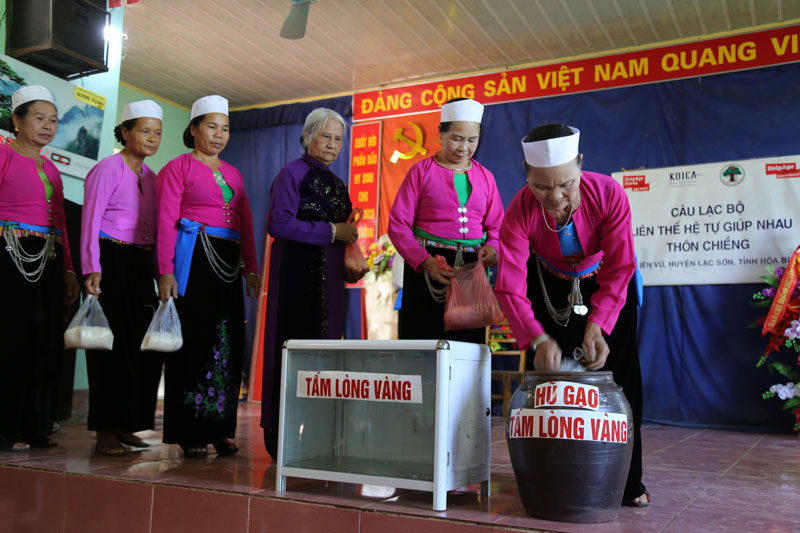
(HBO) – A delegation from the World Bank in Vietnam, the Korean International Cooperation Agency (KOICA) and HeipAge International in Vietnam held a working session on May 13 with the Elderly Association of Hoa Binh province on the outcomes of the building and multiplying of the Intergenerational Self-Help Club (ISHC) model in the locality
The project to assist the disadvantaged elderly through the replication
of ISHC in
Vietnam (Project
VIE 070) is funded by the KOICA through the
Republicof
Korea’s organisation for support of
the elderly, with technical assistance from HeipAge International in
Vietnam.
It covers nine northern localities -
Hanoi, Hai Phong, Vinh Phuc, Hoa Binh, Ninh
Binh, Thai Binh, Hung Yen, Bac Ninh and Hai Duong.
 Representative from the World Bank in
Vietnamand HeipAge International in
Vietnammeet and talk to members of the Intergenerational Self-Help Club in Bung hamlet,
Thu Phong commune (Cao Phong district).
Representative from the World Bank in
Vietnamand HeipAge International in
Vietnammeet and talk to members of the Intergenerational Self-Help Club in Bung hamlet,
Thu Phong commune (Cao Phong district).
So far, Hoa Binh has set up 15 ISHSs in 11 districts and
cities. Over the past one year, the project has attracted nearly 800 people
with the key role of members of the Elderly Association.
Thanks to the attention of the Party Committee, government,
departments, agencies and organisations from provincial to local levels,
operations of the clubs have been regularly and efficiently carried out in
eight aspects of the project, including improvement of income; health care
service; care at home with volunteers’ help; mutual and community support;
spiritual life caring; rights and benefits; resources mobilisation; and
knowledge and awareness enhancement.
In the future, the project will be continue supporting to multiply
and reform of the ISHS model, thus contributing to improving the capacity of
the Elderly Association at different levels as well as local governments in
supporting, managing and expanding the clubs in villages, hamlets and
residential areas.
Earlier the same day, the delegation made a field trip to Intergenerational
Self-Help Club in Bung halmet, Thu Phong commune of Cao Phong district./.
The emulation movement "Hoa Binh joining hands to build new-style rural areas” has been widely spreading, becoming a driving force that motivates the localities to renew rural landscapes and improve the material and spiritual lives of the residents. In this movement, the people play a central role-both as the main implementers and direct beneficiaries of its outcomes.
In response to the global digital revolution, Hoa Binh Newspaper is transforming itself into a modern and multi-platform media hub, blending cutting-edge technology with a restructured newsroom and a new generation of tech-savvy journalists.
Hoa Binh province’s Association of the Elderly recently held a conference to review the project on expanding the inter-generation self-help club model until 2025.
In a move to implement Resolution No. 57-NQ/TW, issued on December 22, 2024 by the Politburo, which targets breakthroughs in science-technology development, innovation, and digital transformation, the Hoa Binh provincial Department of Health has issued a plan to roll out the "Digital Literacy for All” campaign within the local health sector.
An Nghia Commune (Lạc Sơn District) is one of the communes that achieved the tha standard of the national new rural area in 2018. Entering a new development phase, the commune is now trying to meet the criteria for the advanced new rural development. With the strong political will and the public consensus, the commune is gradually overcoming the challenges to reach this goal, aiming for the sustainable development.



